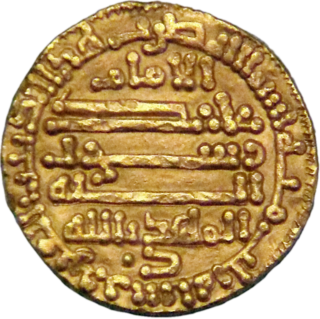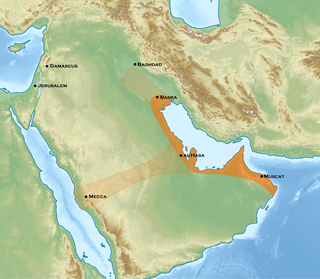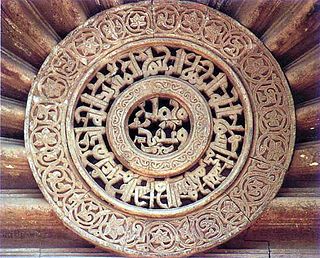Related Research Articles

The Fatimid Caliphate or Fatimid Empire was a caliphate extant from the tenth to the twelfth centuries CE under the rule of the Fatimids, an Isma'ili Shia dynasty. Spanning a large area of North Africa and West Asia, it ranged from the western Mediterranean in the west to the Red Sea in the east. The Fatimids trace their ancestry to the Islamic prophet Muhammad's daughter Fatima and her husband Ali, the first Shia imam. The Fatimids were acknowledged as the rightful imams by different Isma‘ili communities as well as by denominations in many other Muslim lands and adjacent regions. Originating during the Abbasid Caliphate, the Fatimids conquered Ifriqiya and established the city of al-Mahdiyya. The Fatimid dynasty ruled territories across the Mediterranean coast and ultimately made Egypt the center of the caliphate. At its height, the caliphate included—in addition to Egypt—varying areas of the Maghreb, Sicily, the Levant, and the Hejaz.
The Fatimid dynasty was an Arab dynasty that ruled the Fatimid Caliphate, between 909 and 1171 CE. Claiming to be descended from Fatima and Ali and adhering to Isma'ili Shi'ism, they held the Isma'ili imamate and considered themselves the rightful leaders of the Muslim community. The line of Nizari Isma'ili imams, represented today by the Aga Khans, claims descent from a branch of the Fatimids. The Alavi Bohras, predominantly based in Vadodara, also claim descent from the Fatimids.

Isma'ilism is a branch or sect of Shia Islam. The Isma'ili get their name from their acceptance of Imam Isma'il ibn Jafar as the appointed spiritual successor (imām) to Ja'far al-Sadiq, wherein they differ from the Twelver Shia, who accept Musa al-Kadhim, the younger brother of Isma'il, as the true Imām.
Isma'il ibn Ja'far was the eldest son of Ja'far al-Sadiq and the sixth Imam in Isma'ilism. He carried the epithet of al-Mubarak, on the basis of which one of the earliest Isma'ili groups became designated as the Mubarakiyya.
al-Ismāʿīliyya al-khāliṣa / al-Ismāʿīliyya al-wāqifa or Seveners was a branch of Ismā'īlī Shīʻa. They broke off from the more numerous Twelvers after the death of Jafar al-Sadiq in 765 AD. They became known as "Seveners" because they believed that Isma'il ibn Ja'far was the seventh and last Imam. They believed his son, Muhammad ibn Isma'il, would return and bring about an age of justice as Mahdi. Their most well-known and active branch were the Qarmatians.

Abū Muḥammad ʿAbd Allāh ibn al-Ḥusayn, better known by his regnal name al-Mahdī biʾllāh, was the founder of the Isma'ili Fatimid Caliphate, the only major Shi'a caliphate in Islamic history, and the eleventh Imam of the Isma'ili branch of Shi'ism.

The Qarmatians were a militant Isma'ili Shia movement centred in al-Hasa in Eastern Arabia, where they established a religious—and, as some scholars have claimed, proto-socialist or utopian socialist—state in 899 CE. Its members were part of a movement that adhered to a syncretic branch of Sevener Ismaili Shia Islam, and were ruled by a dynasty founded by Abu Sa'id al-Jannabi, a Persian from Jannaba in coastal Fars. They rejected the claim of Fatimid Caliph Abdallah al-Mahdi Billah to imamate and clung to their belief in the coming of the Mahdi, and they revolted against the Fatimid and Abbasid Caliphates.
The Musta‘lī are a branch of Isma'ilism named for their acceptance of al-Musta'li as the legitimate nineteenth Fatimid caliph and legitimate successor to his father, al-Mustansir Billah. In contrast, the Nizari—the other living branch of Ismailism, presently led by Aga Khan IV—believe the nineteenth caliph was al-Musta'li's elder brother, Nizar. Isma'ilism is a branch of Shia Islam.
Abū Ḥanīfa al-Nuʿmān ibn Muḥammad ibn Manṣūr ibn Aḥmad ibn Ḥayyūn al-Tamīmiyy (Arabic: النعمان بن محمد بن منصور بن أحمد بن حيون التميمي, generally known as al-Qāḍī al-Nu‘mān or as ibn Ḥayyūn was an Isma'ili jurist and the official historian of the Fatimid Caliphate. He was also called Qāḍī al-Quḍāt "Jurist of the Jurists" and Dāʻī al-Duʻāt "Missionary of Missionaries".
Muhammad ibn Isma'il al-Maktum was the eldest son of Isma'il al-Mubarak and the seventh imam in Isma'ilism. When Isma'il died, his son Muhammad continued to live in Medina under the care of his grandfather Ja'far al-Sadiq until the latter's death in 148/765. After the death of Abd Allah al-Aftah, Muhammad was the senior most member of this Fatimid branch of al-Husayn's descendants. However, due to the rival group that recognized Musa al-Kazim and the Abbasid persecution of all Fatimids, Muhammad fled Medina with his sons for the east. For this reason, he was known as al-Maktum. He had two sons when living in Medina and then four more sons after his emigration, among whom was his successor Ahmad al-Wafi. Muhammad's descendants became the Fatimid caliphs of Egypt.
Abū Aḥmad ʿAbd Allāh ibn Muḥammad ibn Ismāʿīl, was a descendant of the Islamic prophet Muhammad and the eight of the Isma'ili Imams, succeeding his father, Muhammad ibn Isma'il. Abd Allah traveled throughout Persia and the Middle East. At an unknown date, in the first half of the 3rd/9th century, he found refuge in Syria, where he eventually re-established contact with some of his da'is, and settled in Salamiyah, continuing to pose as a Hashimite merchant. Abd Allah did not reveal his true identity publicly and only a few high ranking Isma'ili hujjats and da'is were aware of his whereabouts. He is known by the epithets al-Wāfī and al-Raḍī. Abd Allah designated his son Ahmad as his successor and died around 828.
Abu al-Husayn Ahmad ibn Abd Allah ibn Muhammad ibn Isma'il, commonly known as Muhammad al-Taqi, was a descendant of the Islamic prophet Muhammad and the ninth of the Isma'ili Imams, succeeding his father, Ahmad al-Wafi. Like his father, he lived primarily in Salamiyah, and Abd Allah ibn Maymun al-Qaddah, the chief missionary, continued to serve as the hijab for him. Known by the title Ṣāḥib al-Rasāʾil, al-Taqi is said to have prepared with his followers an encyclopedic text called the Encyclopedia of the Brethren of Purity. He died in 840 in Salamiyah and was succeeded by his son al-Husayn.
Abu ʿAlī al-Ḥusayn ibn Aḥmad ibn ʿAbd Allāh ibn Muḥammad ibn Ismāʿīl, also known as al-Zakī, al-Raḍī and al-Muqtadā al-Hādī, was a descendant of the Islamic prophet Muhammad and the tenth of the Isma'ili Imams, succeeding his father, Muhammad al-Taqi. Before his death in 881, he entrusted the care of his son and successor, Abd Allah al-Mahdi who was then around 8 years old to his full brother, Sa'id al-Khayr, also known as Abu'l-Shalaghlagh.
The History of Nizari Isma'ilism from the founding of Islam covers a period of over 1400 years. It begins with Muhammad's mission to restore to humanity the universality and knowledge of the oneness of the divine within the Abrahamic tradition, through the final message and what the Shia believe was the appointment of Ali as successor and guardian of that message with both the spiritual and temporal authority of Muhammad through the institution of the Imamate.

The doctrine of the Imamate in Isma'ilism differs from that of the Twelvers because the Isma'ilis had living Imams for centuries after the last Twelver Imam went into concealment. They followed Isma'il ibn Ja'far, elder brother of Musa al-Kadhim, as the rightful Imam after his father, Ja'far al-Sadiq. The Ismailis believe that whether Imam Ismail did or did not die before Imam Ja'far, he had passed on the mantle of the imamate to his son Muhammad ibn Isma'il as the next imam.
The Book of the Sage and Disciple is a religious narrative of spiritual initiation written in the form of a dramatic dialogue by Ja'far ibn Mansur al-Yaman. The work describes the encounter of a disillusioned young man with a dā‘ī, or Isma'ili Muslim missionary, who gradually introduces his new disciple to the inner dimensions of Islam as elaborated by the Shi'a imāms.
Hamdan Qarmat ibn al-Ash'ath was the eponymous founder of the Qarmatian sect of Isma'ilism. Originally the chief Isma'ili missionary in lower Iraq, in 899 he quarreled with the movement's leadership at Salamiya after it was taken over by Sa'id ibn al-Husayn, and with his followers broke off from them. Hamdan then disappeared, but his followers continued in existence in the Syrian Desert and al-Bahrayn for several decades.
Abu'l-Qāsim al-Ḥasan ibn Faraj ibn Ḥawshab ibn Zādān al-Najjār al-Kūfī, better known simply as Ibn Ḥawshab, or by his honorific of Manṣūr al-Yaman, was a senior Isma'ili missionary from the environs of Kufa. In cooperation with Ali ibn al-Fadl al-Jayshani, he established the Isma'ili creed in Yemen and conquered much of that country in the 890s and 900s in the name of the Isma'ili imam, Abdallah al-Mahdi, who at the time was still in hiding. After al-Mahdi proclaimed himself publicly in Ifriqiya in 909 and established the Fatimid Caliphate, Ibn al-Fadl turned against him and forced Ibn Hawshab to a subordinate position. Ibn Hawshab's life is known from an autobiography he wrote, while later Isma'ili tradition ascribes two theological treatises to him.
Ja'far ibn Mansur al-Yaman was an Isma'ili missionary and theological writer of the 10th century. Originally born and raised in Yemen, where his father Ibn Hawshab had established the Isma'ili daʿwa in the late 9th century, he fled the country to the court of the Fatimid caliphs in Ifriqiya, where he remained until his death. He composed poems in praise of the Fatimids' victory over the uprising of Abu Yazid, a biography of his father, and authored or compiled a number of important theological treatises.

The Malikization of the Maghreb was the process of encouraging the adoption of the Maliki school of Sunni Islam in the Maghreb, especially in the 11th and 12th centuries, to the detriment of Shia and Kharijite inhabitants of the Maghreb. The process occurred as Maliki scholars increasingly gained influence, resulting in the widespread acceptance of the Maliki legal school and the subsequent marginalization of other forms of Islam. Malikism was considered a more conservative and mainstream variant of Sunni Islam.
References
- 1 2 3 4 Abun-Nasr, Jamil M. (1987-08-20). A History of the Maghrib in the Islamic Period. Cambridge University Press. pp. 59–68. ISBN 978-0-521-33767-0.
- ↑ Daftary, Farhad (2012). Historical Dictionary of the Ismailis. Scarecrow Press. ISBN 978-0-8108-6164-0.
- 1 2 Daftary, Farhad (1992-04-24). The Isma'ilis: Their History and Doctrines. Cambridge University Press. p. 191. ISBN 978-0-521-42974-0.